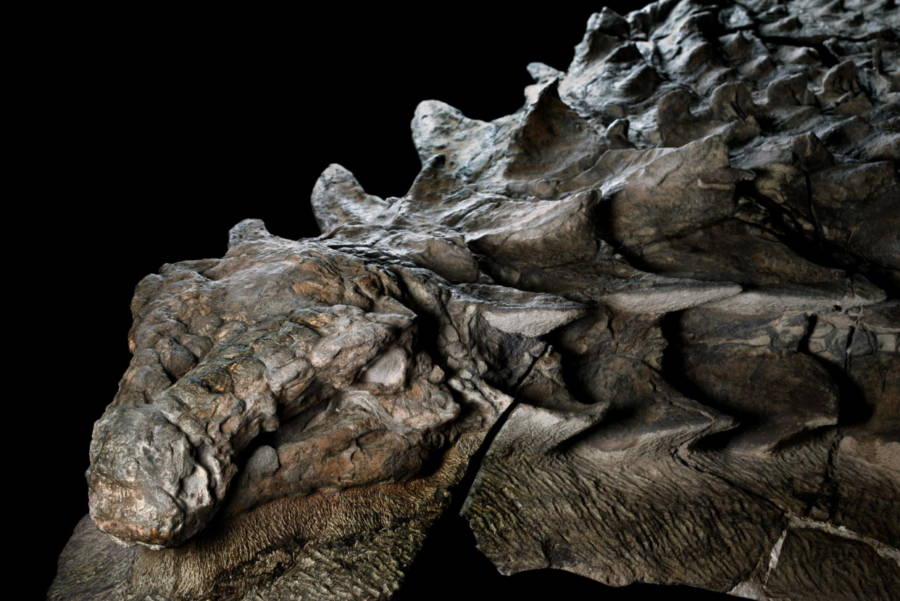"We don't just have a skeleton," said one of the researchers involved in studying the nodosaur. "We have a dinosaur as it would have been."

Robert Clark/National GeographicThe nodosaur is the crown jewel of a dino exhibit at the Royal Tyrrell Museum of Palaeontology in Alberta, Canada.
You can’t even see its bones, but scientists are hailing it as perhaps the best-preserved dinosaur specimen ever unearthed. That’s because those bones remain covered by intact skin and armor — 110 million years after the creature’s death.
The Royal Tyrrell Museum of Palaeontology in Alberta, Canada recently unveiled a dinosaur so well-preserved that many have taken to calling it not a fossil, but an honest-to-goodness “dinosaur mummy.”
With the creature’s skin, armor, and even some of its guts intact, researchers are astounded at its nearly unprecedented level of preservation.
“We don’t just have a skeleton,” Caleb Brown, a researcher at the Royal Tyrrell Museum, told National Geographic. “We have a dinosaur as it would have been.”
When this dinosaur — a member of a newly discovered species called nodosaur — was alive, it was an enormous four-legged herbivore protected by a spiky, plated armor and weighed in at approximately 3,000 pounds.
Today, the mummified nodosaur is so intact that it still weighs 2,500 pounds.
How the dinosaur mummy could remain so intact is something of a mystery, although as CNN says, researchers suggest that the nodosaur may have been swept away by a flooded river and carried out to sea, where it eventually sank to the ocean floor.
As millions of years passed, minerals may have eventually taken the place of the dinosaur’s armor and skin. This might help explain why the creature was preserved in such a lifelike form.
How “lifelike” are we talking? According to Science Alert, the preservation was so good that researchers were able to find out the dinosaur’s skin color.
By using mass spectrometry techniques, researchers detected pigments on the scales of the dinosaur. Apparently, the nodosaur’s coloring was a dark reddish brown on the top of the body — and lighter on the underside.

Robert Clark/National GeographicThe dinosaur was about 18 feet long and apparently built like a tank.
Scientists think the coloring was an early form of countershading — a camouflage technique that uses two tones to protect an animal from predators. Considering this dinosaur was an herbivore, its skin color likely played a role in protecting it from the enormous carnivores of the time.
“Strong predation on a massive, heavily-armored dinosaur illustrates just how dangerous the dinosaur predators of the Cretaceous must have been,” said Brown.
As if the preservation of skin, armor, and guts weren’t impressive enough, the dinosaur mummy is also unique in that it was preserved in three dimensions — meaning that the original shape of the animal was retained.
“It will go down in science history as one of the most beautiful and best preserved dinosaur specimens — the Mona Lisa of dinosaurs,” said Brown.

Robert Clark/National GeographicThe nodosaur has been described by some scientists as the “rhinoceros of its day.”
Although the nodosaur dinosaur mummy was exceptionally well-preserved, getting it to its current display form was still difficult. The creature was, in fact, first discovered in 2011 when a heavy-machine operator accidentally found the specimen while digging through oil sands in Alberta.
Since that lucky moment, it has taken researchers 7,000 hours over the course of six years to test the remains and prepare them for display at the Royal Tyrrell Museum. Now, visitors finally have the chance to gaze upon the closest thing to a real-life dinosaur that the world has likely ever seen.
After this look at the nodosaur, the mummified dinosaur, read up on the recently discovered dinosaur footprint that’s the largest ever found. Then, check out the first-ever dinosaur brain ever found by scientists.





